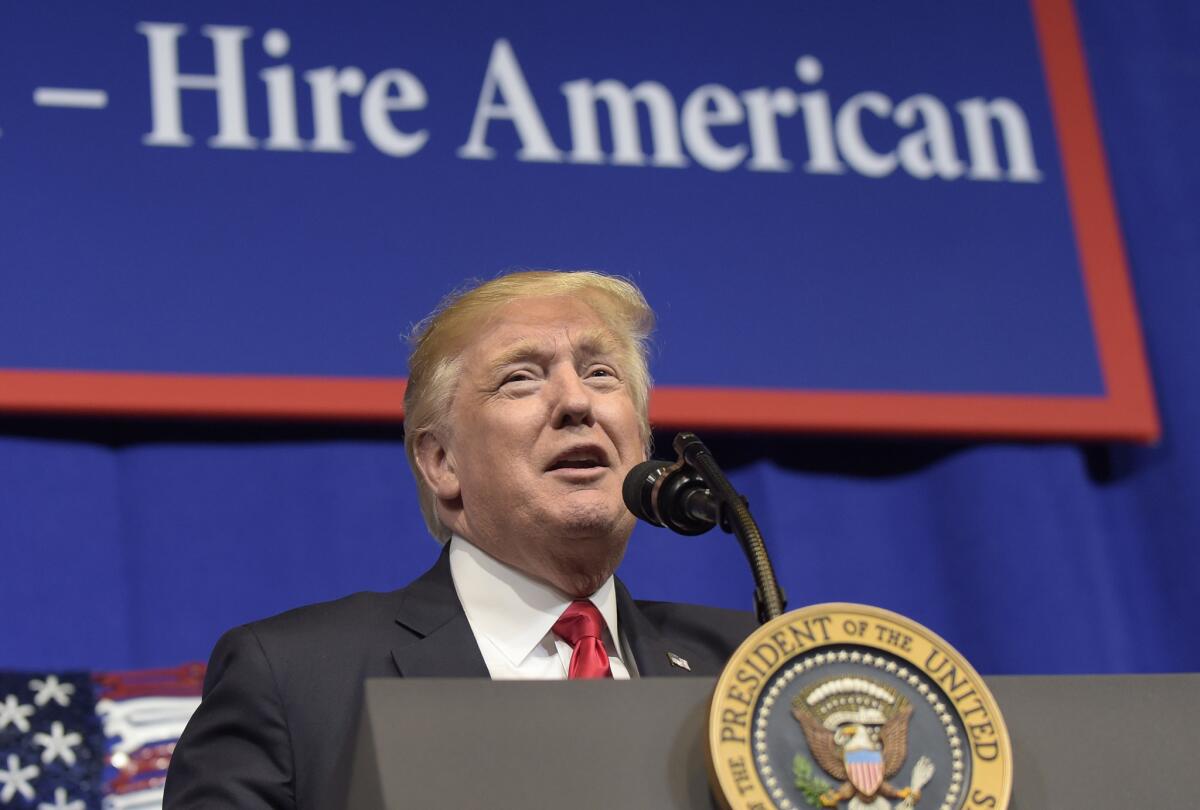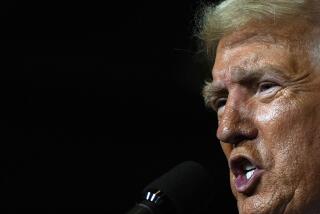Trump’s ‘hire American’ order aims to reshape skilled-worker visa program

Reporting from Washington — Returning to a favorite campaign theme at a time when his domestic agenda has stalled, President Trump on Tuesday ordered a review of a visa program that he said has undercut American workers, declaring his move a “powerful signal” of his administration’s commitment to “finally put America first.”
The White House said the executive action taken by Trump was designed to return the H-1B visa program to its original goal: attracting high-skilled immigrants to the United States in high-wage fields including the tech sector. Currently, administration officials say, the program has been “abused to the point of being rendered … inoperative.”
The order that Trump signed would not make immediate changes in the program, but would set up a longer-term review of how it works.
The administration’s critique of the H-1B program echoed complaints by some in the tech industry that too many of the 85,000 visas allowed each year are scooped up by outsourcing firms that hire relatively lower-skilled tech workers, preventing firms from getting visas that they could use for higher-skilled applicants.
Ultimately, however, the administration would like to take the changes further. The review of the H-1B program would be a “transitional step” toward a revamped immigration system, officials said.
Critics noted, however, that Trump was not cutting back on other guest-worker visa categories, such as the H-2B program for low-skilled nonagricultural workers under which foreigners have been hired to work at his Mar-a-Lago estate.
Trump, who spoke at a Wisconsin manufacturing plant, said his trip was in part to thank voters who had supported him last November. The state had been in the Democratic column for three decades in presidential elections until that point. As he spoke, he looked out at an audience dotted with the red “Make America Great Again” hats that were a symbol of his upset victory.
“Those are good hats,” he said.
Trump has struggled to regain his footing since his bid to repeal and replace the Affordable Care Act stalled out in Congress. The administration initially had planned that in April, Trump would be pivoting from success on healthcare to another major initiative: tax reform.
But instead of signing legislation that has long been a goal of his party, Trump is in the position of issuing another primarily symbolic executive directive championed by nationalist advisors.
Trump, though, said he hadn’t given up on big-ticket items, claiming that Republicans were “in very good shape on tax reform.” In fact, the administration has not yet come up with a proposal, House and Senate Republicans are not close to agreement and Treasury Secretary Steven T. Mnuchin admitted Monday that his goal of a tax reform bill by August was unlikely to be achieved.
Trump also repeated that he has not give up on repealing Obamacare.
“Healthcare — we have to get the healthcare taken care of,” he said, urging those in the audience to press their members of Congress on the issue. “As soon as healthcare [is] taken care of, we’re going to march very quickly. We’re going to surprise you.”
The order that Trump signed also initiates a separate review of government purchasing practices with the goal of more strictly enforcing “buy American” requirements that officials said have been diluted over time by exemptions.
“The policy of our government is to aggressively promote and use American-made goods and to ensure that American labor is hired to do the job,” Trump said at the Kenosha, Wis., plant. “It’s America first, you better believe it.”
A senior administration official, briefing reporters Monday on the condition of anonymity ahead of the president’s event, said the goal of the H1-B program review would be to shift the process for awarding the visas to put a priority on higher-skilled and higher-paid workers, making it more difficult to use it to replace American workers.
Trump’s plan is consistent with the “buy American, hire American” credo that was a staple of his campaign, featured prominently in his inaugural address and outlined in his address to Congress in February. Previewing the announcement, the White House distributed polling data demonstrating the breadth of public support — from members of both parties — for the concept. (The information was attributed to a Democratic pollster, the Mellman Group; a Mellman executive expressed surprise upon being told that the White House had distributed the firm’s data).
“Working-class voters ... Republican, Democrat, independent, are going to be the most enthusiastic to have guest worker reform,” one senior administration official told reporters Monday.
Indeed, the action was cheered by organized labor while the U.S. Chamber of Commerce, a staple of the Republican coalition, was more circumspect.
“It would be a mistake to close the door on high-skilled workers from around the world who can contribute to American businesses’ growth and expansion,” the group’s senior vice president, Neil Bradley, said in a statement, while conceding that the program “can be improved.”
The Trump administration’s proposals and comments on changing the temporary worker visa program were met with some wariness by policy analysts and economists.
They generally agreed that the existing H-1B rules need better enforcement to thwart abuse and ensure that requirements on worker qualifications and salaries are being met. These experts also favor replacing the existing lottery system with a merit-based system to attract more high-skilled workers.
At the same time, analysts found that some of the analysis and statistics provided by the White House to be simplistic and unsupported.
Robert D. Atkinson, president of the Information Technology and Innovation Foundation, a nonpartisan research group in Washington, took issue with an administration official’s claim that about 80% of H-1B visa workers are paid less than the median wage in their fields.
“We’ve shown that the typical H-1B worker is better paid, by occupation, than native workers,” he said.
Other academic and government studies have found more mixed results. A 2011 report by the U.S. Government Accountability Office, the investigative arm of Congress, said H-1B visa holders working as systems analysts and computer programmers tended to earn less than U.S. workers, but some of that gap was explained by differences in age. There was no statistical difference in median pay between visa holders and U.S. workers for electronics and electrical engineers or college and university educators, that report found.
While the U.S. needs to make sure that companies pay the correct wage, said Stephen Yale-Loehr, an immigration expert at Cornell University Law School, officials should be careful not to harm innovation in the process.
Immigrants account for a disproportionately large share of start-ups and patents in the U.S. Yale-Loehr said that for every H-1B position requested, U.S. tech companies increase their employment by five workers — similar to a claim made a few years ago by Bill Gates of Microsoft.
Trump’s executive order, he said, was “an overly simple solution to a complex problem.”
For more White House coverage, follow @mikememoli on Twitter.
ALSO
How important is Georgia’s special election for Republicans? Trump’s Twitter feed gives you a clue
The real goal of Trump’s executive orders: Reduce the number of immigrants in the U.S.
More to Read
Sign up for Essential California
The most important California stories and recommendations in your inbox every morning.
You may occasionally receive promotional content from the Los Angeles Times.












